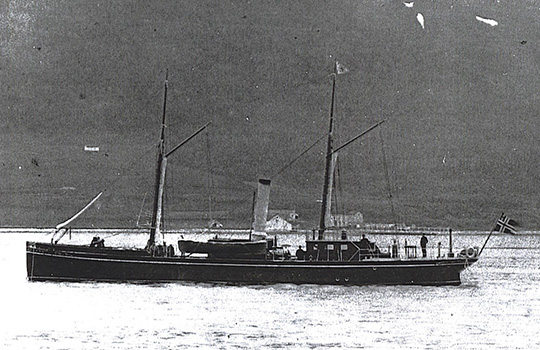
Tromsø Harbor, ca. 1880
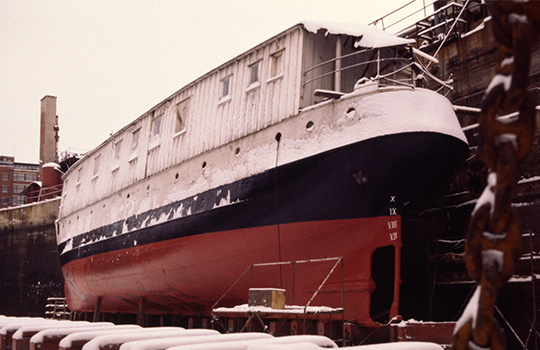
Nyland Yard, Oslo, 1979
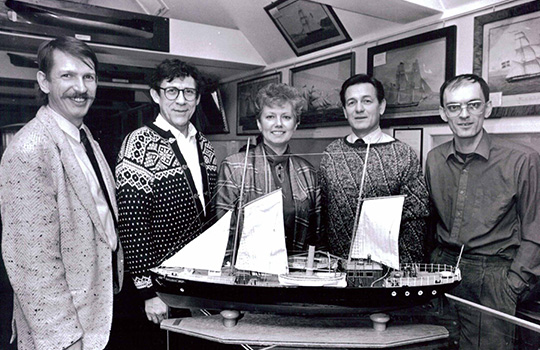
First Hansteen board meeting, 1987
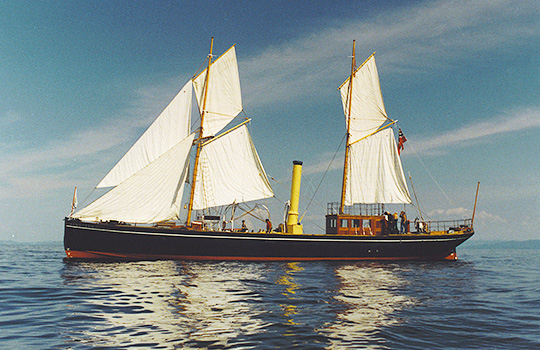
Trondheimsfjord, 1993
The sail steamship HANSTEEN was built of iron by Nyland in Christiania (later Oslo), Norway in 1866 for the Government of Norway as a depth sounding and mapmaking ship for The Geographical Survay of Norway (Norges Geografiske Oppmåling, NGO).
It was 120 tons, 101 feet long, with a beam of 15 feet, and was fitted with a two-cylinder, high-pressure steam engine and six sails. The Lieutenant in Command and his 14-men crew came from the Royal Norwegian Navy. From 1867-1897 the ship made depth soundings off the coast of Norway, in addition to accommodating King Oscar II in 1872, solving fishing boundary disputes with Russia, and conducting deep sea explorations.
In 1875 at the World Exposition in Paris, ocean surveying done aboard the HANSTEEN received a gold medal and a diploma for excellent new hydrographic work.
In 1898 the Government sold the ship to Inherred Forenede Damskibsselskaber that converted it to a cargo, post and passengers' vessel. It did not work well. Shortly after it was sold again, this time to Sandnessjøen for service as a local passenger ferry. It was renamed HAAREK. In 1916 it was remodeled, and this time a new weather deck was added. It made the ship better suited for passengers, serving both the fjords and the islands off the coast of Norland, including the remote island of Træna for more than a generation.
Found as a homeless shelter in Oslow 1977, its name was The Old Boat.After 82 years in steam HAAREK was slated for demolition, but ended up in Florø as lodging ship for herring packers and was renamed IVAR ELIAS. A barrack was added on the top deck. The ship was later moved to Oslo as a hostel for the homeless.
In 1978 she was closed down and scheduled to be burned. Olaf T. Engvig had written to various maritime organizations and tried to drum up interest in saving the ship. No official body or nonprofit organization rose to the task. The initiative ended with him taking over the ship himself. Volunteers joined, and a long restoration process started.
The volunteers and Engvig started Veteranskipsreparasjoner A/S, a shipyard specializing in restoration of old ships at the site of the closed-down Nylands Verksted in Oslo. They re-introduced riveting in Norway as a restoration technique for historic ships.
In 1993, HANSTEEN was completed as the first fully restored major ship in Norway. The entire hull was approved by the ship controlling authorities. By then, Olaf Engvig had sacrificed a regular career and had given 15 years of his life without regular income in order to save and restore the ship.
When the HANSTEEN was finished, it was steamed to Trondheim under Lieutenant Engvig's command. It happened 95 years after the last navy lieutenant had commanded the vessel. Olaf Engvig gave research vessel HANSTEEN to a nonprofit organization in Trondheim, to be saved and cared for in the future.
According to the official transfer document, one of the requirements for the transfer is that HANSTEEN is equipped and saved as it was as a depth sounding and mapmaking vessel from the latter part of the 1800s, and protected as an historic ship. It shall be used in line with this purpose and for the promotion of research and education.
A detailed account of the restoration of HANSTEEN is included in Olaf Engvig's newest book, Viking to Victorian: Exploring the Use of Iron in Ship Building. The use of British iron from Bloomfield Ironworks in HANSTEEN is compared to iron from Consett Iron Works and Walker Iron Works used in the STAR OF INDIA (originally EUTERPE, built at Ramsey, Isle of Man in 1863.)
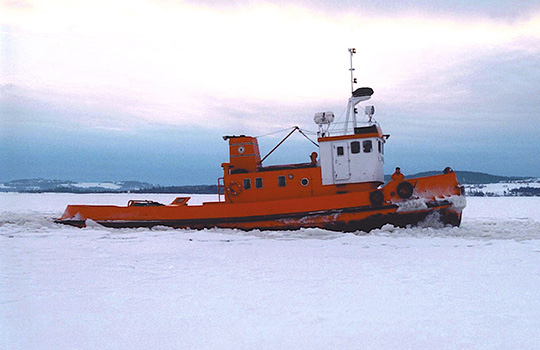
Icebreaking, 1997
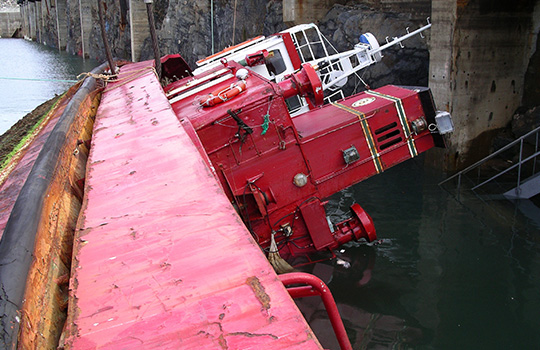
Docking accident, 2004
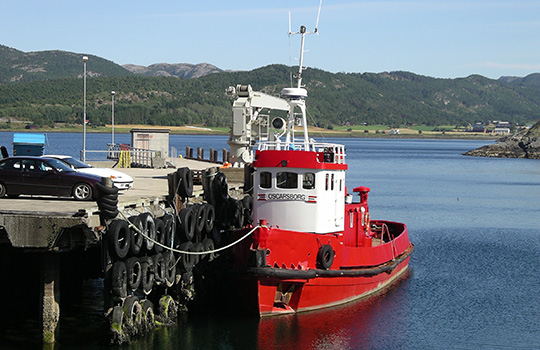
Hysnes, 2007
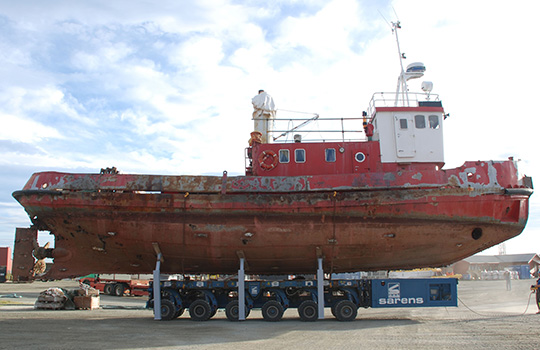
Saved on land, 2017
BORGEN (the Fortress), as OSCARSBORG often is called, has an unusually long and unique history unlike any other ship on the Norwegian coast. This tugboat was built of iron from Bloomfield Iron Works in England, by Akers mek. Verksted in 1874. It was paid for by the Norwegian government. OSCARSBORG might very well be Norway's most original old ship. When decomissioned, the tug had been in continuous service for more than 127 years.
OSCARSBORG was the commanding ship in one of Milorg's most successful operations in occupied Norway during World War II. The tug started service by towing barges carrying rocks for the construction of the Oscarsborg-jetee in the Drøbak narrows of the Oslofjord. A direct result of this work was the sinking of the German heavy cruiser BLUCHER during the invasion of Norway on April 9, 1940.
Since then, OSCARSBORG has been assisting all kinds of ships - from the windjammer CHRISTIAN RADICH to large whaling factory ships fully loaded with oil from their season in Antarctica. It has pulled large tanker hulls in the currents of Norway's largest river, the Glomma; towed factory items; assisted the national railroad; and taken members of political parties out on short cruises.
BORGEN has also served as an icebreaker, and assisted cruise ships, new oil-rigs, nuclear attack US subs like ALBANY and MEMPHIS on missions to Norway, and saved all kinds of ships in distress, including the USS BOULDER. It has even been a pilot and police boat and has been issued a passenger certificate for 40 people.
The most special aspect about this 69-foot long tugboat is that it has never been restored. OSCARSBORG'S longevity is due to its sturdy construction, its usefulness, and its value in active duty. BORGEN is small and strong, quite a muscle tug. It is incredible how many exciting adventures this tugboat has been part of. Salvage tug OSCARSBORG has become a living legend on the coast of Norway.
The book "Slepebåten " (in Norwegian) by Olaf Engvig is available from the Norwegian publisher Academica (www.akademikaforlag.no).
In spite of a promise from the state antiquarian, the ship received no funds in 2012 or 2013. It was then decided to put the ship on land to save it for future generations. The 107 ton heavy tug was lifted ashore by two cranes and placed on a six axle transporter (see below). It took OSCARSBORG to its final resting place next to the VÆRDALEN. Two genuine ships built from iron are on display in what will hopefully be a museum for iron-built tonnage made before the 1890s, when the world's shipbuilding switched to steel.
As of 2023, the 149-year old historic vessel OSCARSBORG is still waiting for funds to repair the engine room after capsizing in the dock in 2004.
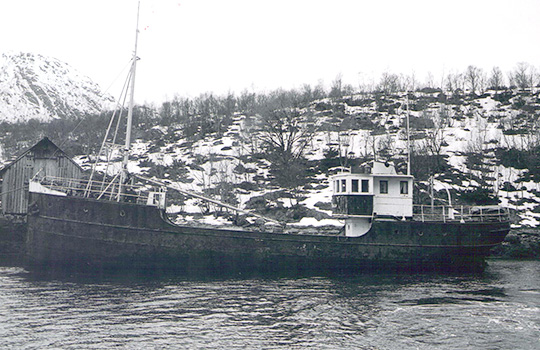
Northern Norway, 1979
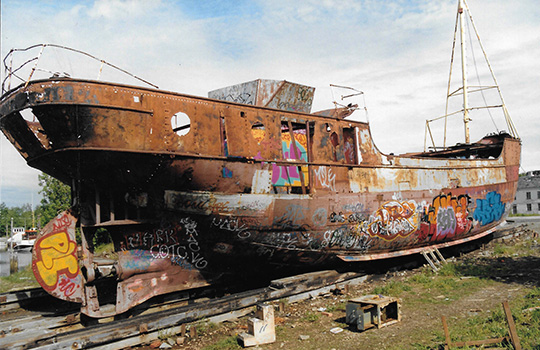
Vandalism, 1995
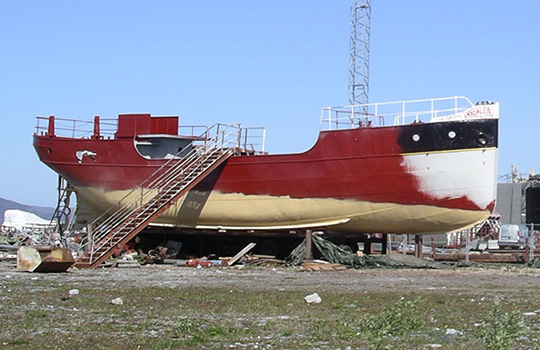
Repairs at Fosen, 2014
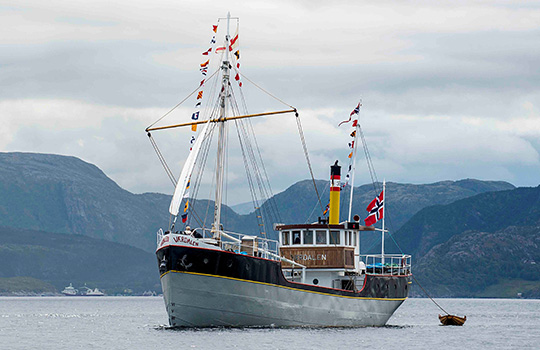
Back at Sea, 2016
VÆRDALEN's history includes 56 years of fjord steaming and 30 years in coastal trade. This lumber schooner was contracted by Verdalsbruket from Trondhjems Mek. Verksted. It steamed between Verdal and Trondheim with lumber products and called on several ports en route. Her poop deck was extended forward in 1928 to make room for more passengers. Twenty years later the VAERDALEN's original appearance was reinstated when the ship was converted back to a general freighter.
During World War II the VÆRDALEN was used to support clandestine missions to smuggle radio operators educated in Sweden into Trondheim for transmission to London of German war activities in this very important enemy port. The VÆRDALEN was the little local ship that steamed right under the nose of German units, such as the TIRPITZ, SCHARNHORST and LUTZOW, with full inspection on board. The young concealed radio operator would be in a secret compartment with his radio, batteries, and a pistol in his lap, ready to fire if the agreed signal did not appear before the hatch was opened. Half of all radio operators in Norway were captured and shot, but none were taken on the VÆRDALEN. Vaerdalen in 2011 - restored.After the war, VÆRDALEN worked all along the Norwegian coast from Lindesnes to North Cape, and even delivered the sand for the restaurant on the North Cape Plateau. This ship became the pioneer in providing the fishing fleet with frozen bait. It delivered fresh winter cod from Lofoten to the railroad at Mo i Rana for speedy transport to the continent. During the 1950-60's herring adventure off the Norwegian Coast, VÆRDALEN was used to carry the catch from the fishing grounds to the receiving wharf. It sailed in the general cargo trade on the coast and signed off its working days as a sand freighter in Vesterålen when it was more than 86 years old. It was laid up at Kvitnes scheduled to be sunk to become a breakwater, when it was saved for preservation. It had no machinery and leaky decks, but the rest was good. A new engine was installed. In the summer of 1981 VÆRDALEN steamed the 600 nautical miles back to Trondheim. She is the last operational steam schooner and is considered one of the most interesting historic ships left in Scandinavia from the nineteenth century.
VAERDALEN PARTICULARS
Lumber schooner, one deck. Built 1891 by Trondhjems Mek. Verksted, yard # 61, of iron and steel. Length 83' 3", beam 16' 6", depth 5' 1", dpl. 112 ton, straight steam, counter stern, flat bottom, forecastle 20', poop 33', hatch 23', hold 40', two masts, long boom, schooner rig, sails. Forward: Sailor's cabin, mess, toilet, stores. Aft: Passengers' saloon, captain's and officers' cabins, mess, galley, toilet, engine casing, stairs. Cabin on deck. Engine: Detroit Diesel 110, 220 bhp, speed 11 knots. Original: Bremme Compound 10" x 21" x 12", 110 IHP. Boiler: Return tube, 6' 9" x 6' 9", 140 lb., 1 furnace, coal fired.
Back to Sea!
After an extremely long and painstakingly slow ship restoration, without any funding whatsoever from the government, the 124 year old VÆRDALEN, a passenger, mail and lumber schooner, has gone back to sea.
Below you can see some before and after pictures of the VÆRDALEN. On September 18, 2015 there was a trial run at Fosen, Norway. The next day was a windy and gray day but 6 people got an early start. The voyage was a six-hour run on the Trondheimsfjord at 10 knots from Rissa to Verdal, a small Norwegian city.
As you can imagine from seeing the dramatic difference, it took 36 years with an enormous amount of volunteer work, but the VÆRDALEN is now a restored and seaworthy ship. It's the only surviving hybrid (push-pull) ship. You can read more about the restoration in this Hybrid Ship VÆRDALEN Launched Anew! pdf.

Winner for the 9th Karl Kortum Maritime History Award
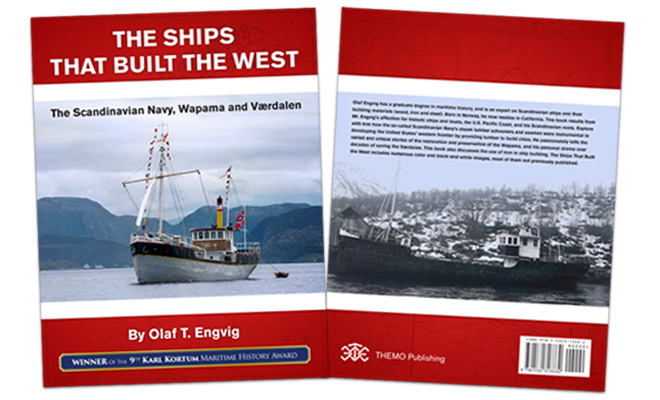
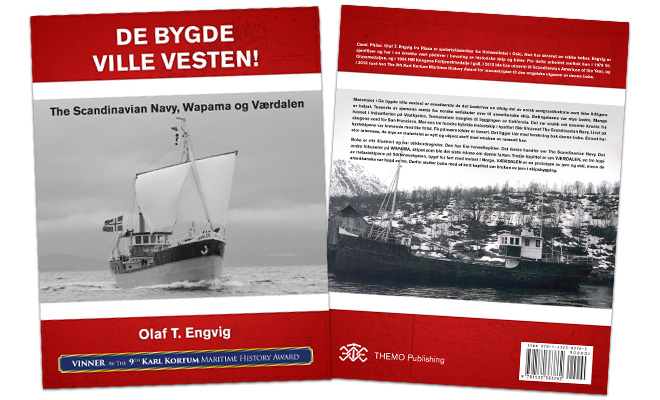
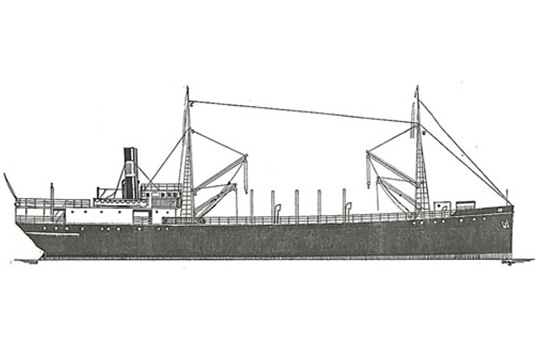
Drawing of Hestmanden, ca. 1980
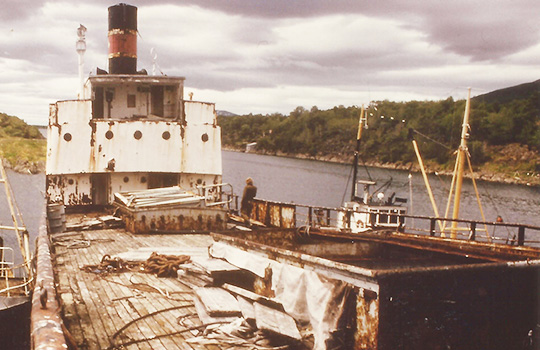
Meisfjorden, 1981
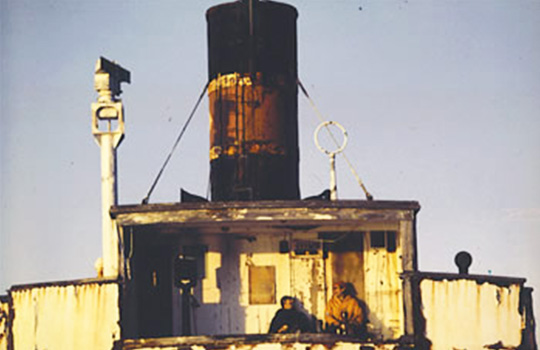
Petter Olsen, Olaf Engvig on the Tow, 1983
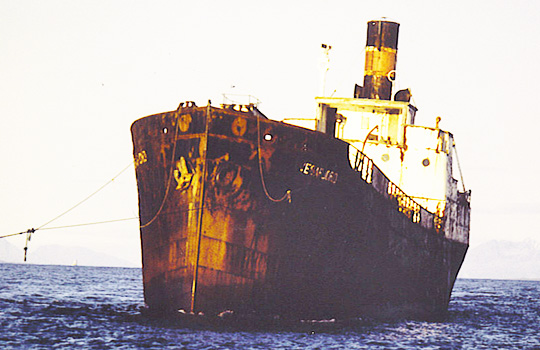
Coast of Norway, 1983
HESTMANDEN was built of steel by Laxevaag mek. Verksted, Bergen in 1911 for Vesteraalen A/S D/S. It is a general cargo ship, 56.7 meters long and 755 GRT, with a reciprocating triple expansion, a steam engine of 475 HP, and speed of 7 knots. Designed for hauling dry cargo along the coast of Norway, it would occasionally steam in the North Sea trade. It was rebuilt by Aker in 1948. Hestmanden.The ship sailed on the British Isles during WWI, assigned to the British in 1917 for coastwise service. During the inter-war period she took up her original business serving ports along the Norwegian coast.
During the German invasion of Norway in 1940, HESTMANDEN was in Northern Norway. The Captain decided to flee the country; cast off and set a course into the Atlantic. After two days they found a British convoy, once more ending up sailing on the British coast. HESTMANDEN was included in Nortraship, the Government of Norway's Shipping Mission for all tonnage outside occupied Norway. HESTMANDEN once again saw close calls during enemy actions but survived WWII as it had WWI.
After the War HESTMANDEN helped rebuild the country, hauling pre-fabricated houses and other goods for the reconstruction of Finmark where every structure had been burnt by withdrawing German troops Hestmanden Engine.(scorched earth tactics). During the early 1950s this ship was known by sailors in the Merchant Marine as the slowest ship of the entire fleet. All kinds of jokes were told regarding the HESTMANDEN and its Boson who stayed on board for ages. In 1955 it was sold to Høvding Ship Breakers, renamed VEGAFJORD, and served as a storage, supply and salvage ship during many salvaging operations, among them raising sunken German submarines. VEGAFJORD was laid up in 1965.
In February 1979 Olaf Engvig made a phone call to the Director StrØmseng of Høvding Ship Breakers at SandnessjØen regarding parts for the restoration of the HANSTEEN, which had started. During that call Engvig was told that they would start breaking up the HESTMANDEN the following month. Olaf Engvig knew it had to be the last ship from Nortraship still alive in Norway, and the Director agreed; adding that Einar Høvding himself had tried to get a museum interested in having her in the early 1970's but they declined the offer. Engvig asked for time until after Easter in trying to save her, as he had saved the HANSTEEN shortly before. The Director gave Olaf the time he needed, provided his boss, Einar Høvding, was kept informed.
Engvig contacted Norsk Veteranskibsklub (NVSK) , where he was a member, owner of S/S BOROYSUND . They knew nothing about HESTMANDEN, but were willing to look into the matter. Engvig wrote an article with pictures for Aftenposten, April 24, 1979. Several more articles followed. People learned about the ship. Petter Olsen came up with the money and the Club agreed to assume ownership. NVSK negotiated a deal for the HESTMANDEN, and in addition even managed to get the tug S/S STYRBJORN, also a ship ready to be broken up.
It took some time before the group could get the two historic vessels out of Sandnessjøen. In 1982 both ships were towed to Trondheim by the Coast Guard, and Olsen and Engvig were invited to come along for the ride.
HESTMANDEN was drydocked, cleaned and surveyed - the first few steps back to life as part of the country's maritime heritage.
By 2005 STYRBJORN had been restored to steaming condition, while HESTMANDEN was well on its way to full restoration in Kristiansand.
The strong argument for saving the ship was that the HESTMANDEN was genuine and had steamed during WWII, making it a sole remembrance of the war sailor's life.
In 2011 Peter Olsen and Olaf Engvig were invited as special guests at the baptismal for the ship in Kristiansand and a lunch with His Majesty King Harald. Today the HESTMANDEN is a monument for war veteran sailors.
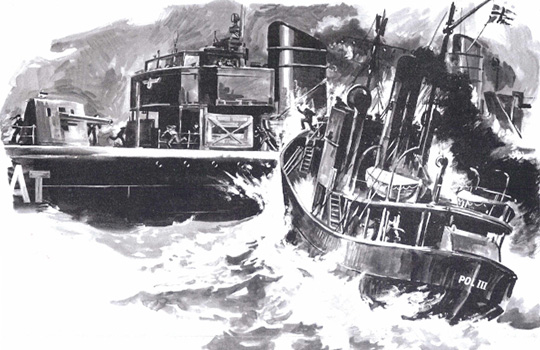
Nazi Invasion of Norway, 4/9/1940
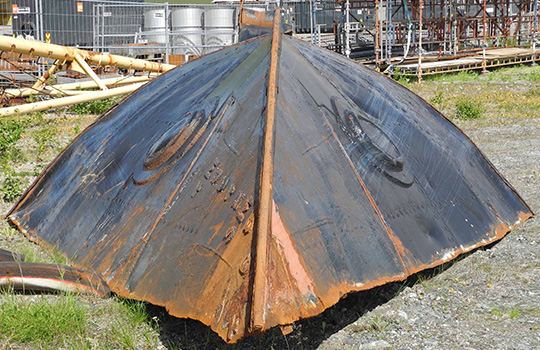
Bow Saved, 2012
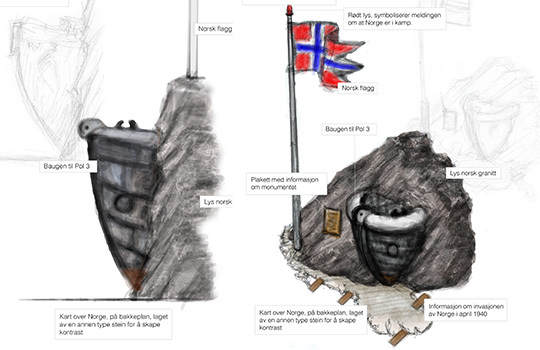
Sketch Invasion Monument, 2013
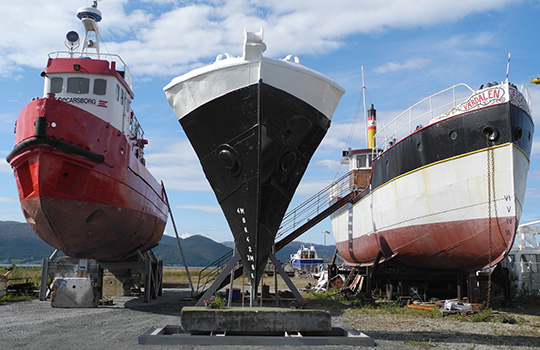
Bow Raised, Fosen, 2014
Olaf Engvig saved the bow of POL III when the ship was broken up. POL III was the neutrality patrol ship that discovered and tried to slow down the Nazi invasion of Norway in April 1940. The captain was killed, becoming the very first casualty in Norway during WW II.
The ship sent a signal to a fort up the Oslofjord, and a retired commander there manned the ancient cannons and shot at BLUCHER, a humongous German war ship heading for Oslo. The ship sank, and this delayed the Nazi invasion for a few crucial hours. This meant that there was enough time to get the Royal family and the gold in the Bank of Norway away from the Nazis and eventually over to England. The Norwegian King Haakon and his family had a tremendous actual and symbolic influence on the war effort in Norway.
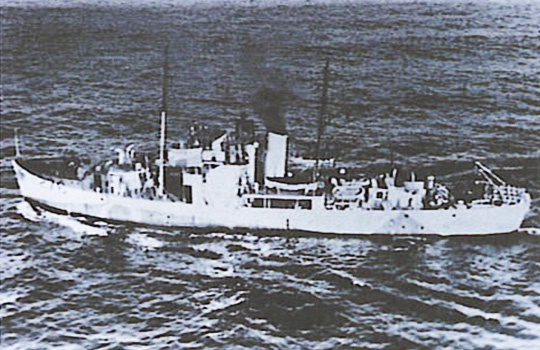
On Patrol, North Atlantic, 1943
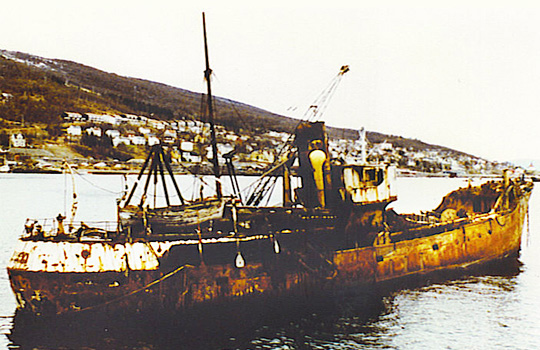
Waiting to be Scrapped, Narvik, 1980s
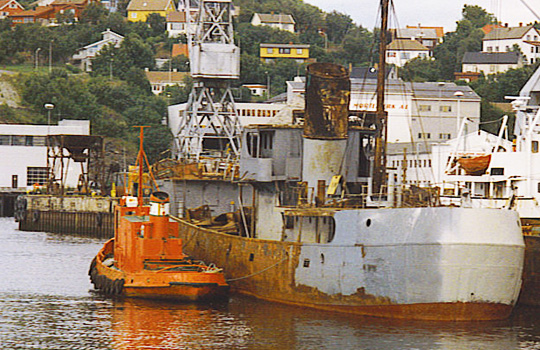
Trondheim, 1991
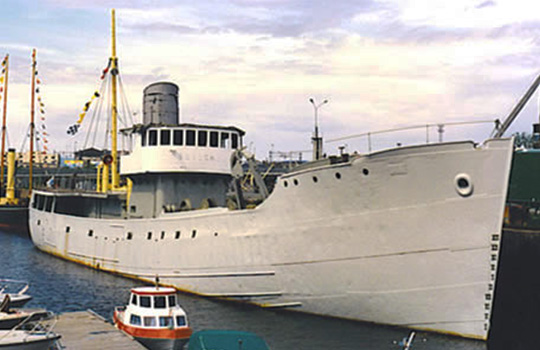
Hull Painted, 1992
T-276 "CAILIFF" was built at Collingwood, Ont., Canada, by Admiralty for Royal Navy - one of hundreds of ships needed to protect convoys and challenge the enemy submarine warfare. She was commissioned in September of 1942 and served with Halifax Defense Force during "The Battle of the Atlantic", also stationed at St. John's, Newfoundland serving with that Local Defense. T-276 did coastal convoy escort, screening and other military service. In 1945 she got ordered to pick up two surrendering German U-boats. She was returned to UK in June 1945. In 1947 T-276 was sold to Norway and converted to a side-trawler, kept her steam plant, and was renamed "BORGENES". She fished on the oceans until 1973 when she was laid up and sank. She was raised and used i breaker's storage. In 1989 "BORGENES" was towed to Trondheim to become a youth working project. The hull is surprisingly good, engine, boiler and valves need attention, and the superstructure needs to be modified to WW2 appearance, an easy task for an experienced shipyard. The Isle Class served with several allied nations, including Norway, during and after the war and worked on all oceans. They were the smallest vessels to sail with the convoys, but the propulsion, Asdic and 32 depth charges made this ship a fighting unit with considerable potential against submarines.
Particulars:
War losses 10 %. About half in 1943 by U-boat, three off Normandy/Channel, June-Nov. 1944. T-278 CAMPOBELLO, built alongside the T-276 foundered in N. Atlantic 3.1943. Class motto: WHERE FLEETS GO - WE HAVE BEEN!
After being saved for 24 years as an historic ship, and with close to 10 million NOK put into the ship, the state antiquarian of Norway gave permission to send the BORGENES to the breakers, even though the ship had been declared to be a protected ship by the same office years ago. The very last Isles Class A/S S/T was towed to the breakers and broken up in 2012.
Ultrasound measurement of the entire hull during the 1990s showed surprisingly good plates with adequate thickness. The ship was good but there was no will by the people to keep it.